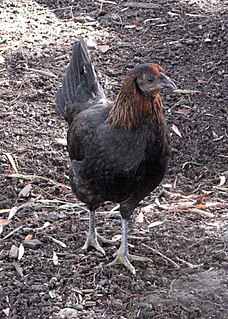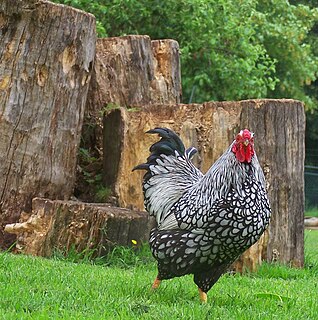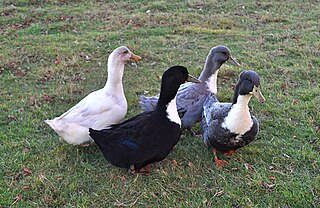
Poultry are domesticated birds kept by humans for their eggs, their meat or their feathers. These birds are most typically members of the superorder Galloanserae (fowl), especially the order Galliformes.

The American Game is an American breed of game fowl, chickens bred specifically for cockfighting. It has many color varieties, and may also be kept for ornament.

The Araucana is a breed of domestic chicken from Chile. Its name derives from the Araucanía region of Chile where it is believed to have originated. It lays blue-shelled eggs, one of very few breeds that do so.

The Rhode Island Red is an American breed of domestic chicken. It is the state bird of Rhode Island. It was developed there and in Massachusetts in the late nineteenth century, by cross-breeding birds of Oriental origin such as the Malay with brown Leghorn birds from Italy. It was a dual-purpose breed, raised both for meat and for eggs; modern strains have been bred for their egg-laying abilities. The traditional non-industrial strains of the Rhode Island Red are listed as "watch" by The Livestock Conservancy.

The Dorking is a British breed of domestic chicken. It is named for the town of Dorking, in Surrey in southern England.

The Cochin is a breed of large domestic chicken. It derives from large feather-legged chickens brought from China to Europe and North America in the 1840s and 1850s. It is reared principally for exhibition. It was formerly known as Cochin-China.

The Malay is a breed of game chicken. It is among the tallest breeds of chicken, and may stand over 90 cm high. The Malay is bred principally in Europe, and in Australia and the United States. It was derived, partly in Devon and Cornwall in south-west England, from birds imported from Indian subcontinent or South-east Asia in the first decades of the nineteenth century, when large birds of this type were widespread in northern India, in Indonesia and in the Malay Peninsula.

The Sussex is a British breed of dual-purpose chicken, reared both for its meat and for its eggs. Eight colours are recognised for both standard-sized and bantam fowl. A breed association, the Sussex Breed Club, was organised in 1903.

The Scots Dumpy is a traditional Scottish breed of chicken. It is characterised by very short legs, so short that the body is a few centimetres from the ground; as in other breeds of creeper chicken, this chondrodystrophy is caused by a recessive lethal allele. The Dumpy has at times been known by other names, among them Bakie, Corlaigh, Crawler, Creeper and Stumpy. There are both standard-sized and bantam Scots Dumpies. It is one of two Scottish breeds of chicken, the other being the Scots Grey.

The Plymouth Rock is an American breed of domestic chicken. It was first seen in Massachusetts in the nineteenth century, and for much of the early twentieth century was the most popular chicken breed in the United States. It is a dual-purpose breed, raised both for its meat and for its brown eggs. It is resistant to cold, easy to manage, and a good sitter.

The Old English Game is a British breed of domestic chicken. It was probably originally bred for cockfighting. Two different standards are recognised by the Poultry Club of Great Britain: Carlisle Old English Game and Oxford Old English Game. There is also an Old English Game bantam.

The Wyandotte is an American breed of chicken developed in the 1870s. It was named for the indigenous Wyandot people of North America. The Wyandotte is a dual-purpose breed, kept for its brown eggs and its yellow-skinned meat. It is a popular show bird, and has many color variants. It was originally known as the American Sebright.

The Swedish Blue or Blue Swedish is a Swedish breed of domestic duck. It emerged during the nineteenth century in what was then Swedish Pomerania, now divided between north-west Poland and north-east Germany.

The Sebright is a British breed of bantam chicken. It is a true bantam – a miniature bird with no corresponding large version – and is one of the oldest recorded British bantam breeds. It is named after Sir John Saunders Sebright, who created it as an ornamental breed by selective breeding in the early nineteenth century.

The Buckeye is a breed of chicken originating in the U.S. state of Ohio. Created in the late 19th century, Buckeyes are the only standard breed recognized by the American Poultry Association (APA) that is known to have been developed by a woman. It is the only breed in the American Class to have a pea comb. As of 2014, Buckeyes are listed as "Threatened" by The Livestock Conservancy. The breed's name is derived from Ohio's nickname of "Buckeye state". Their mahogany color is said ideally to resemble the seeds of the Ohio Buckeye plant. They are a dual-purpose chicken, known both for laying productivity and meat characteristics. Buckeyes are yellow-skinned chickens that lay brown eggs.
The Nankin Bantam or Nankin is a British bantam breed of chicken. It is a true bantam, a naturally small breed with no large counterpart from which it was miniaturised. It is of South-east Asian origin, and is among the oldest bantam breeds. It is a yellowish buff colour, and the name is thought to derive from the colour of nankeen cotton from China.

The Silver Appleyard is a British breed of domestic duck. It was bred in the first half of the twentieth century by Reginald Appleyard, with the aim of creating a dual-purpose breed that would provide both a good quantity of meat and plenty of eggs. It is critically endangered.

The Saxony, German: 'Sachsenente', is a German breed of domestic duck. It was bred in Saxony in the 1930s, but because of the Second World War was recognised only in 1957.
The Crystal Palace Poultry Show was a poultry show held at The Crystal Palace in London in the United Kingdom. They ran from 1857-1936, with interruption by World War I. It was the world's largest poultry exhibition at several times in its existence, considered the pinnacle of poultry exhibition in the British Empire and despite being a poultry show also allowed the exhibition of domestic rabbits. It was hosted by the Grand International Poultry, Pigeon and Live Stock Shows, Ltd which was liquidated in 1964. The show was superseded in its role by the International Poultry Show, Olympia which has also ceased to exist since.

















